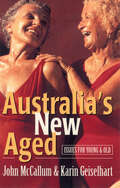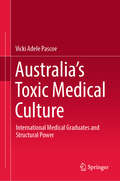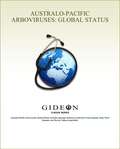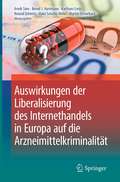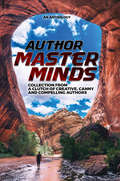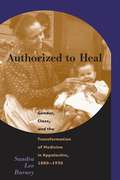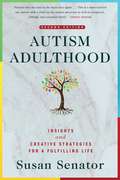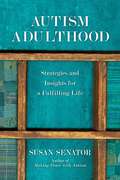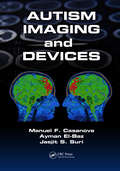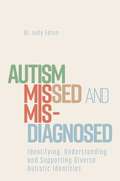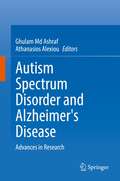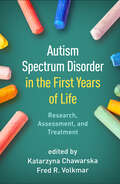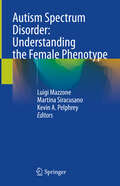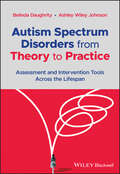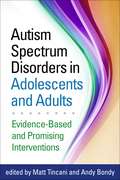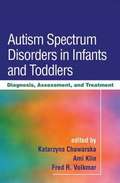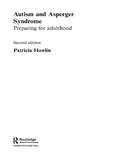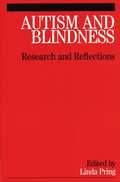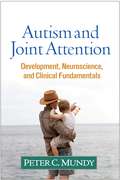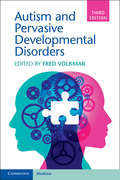- Table View
- List View
Australia's New Aged: Issues for young and old
by John McCallumThe idea that our society is ageing is a popular source of gloomy predictions for the future. We see today's youth struggling in their mature years to pay for the masses of geriatric baby boomers whose productive years lie far behind.Australia's New Aged shows that this belief is part reality and part myth. While there will be an increase in the proportion of aged people in the next 20 years, this is a temporary phenomenon and it is likely that tomorrow's elderly will quite differently from their parents.Australia's New Aged examines public policy for the aged in the context of an increasingly vocal and active elderly population and cutbacks to health and welfare spending. The authors argue that policy makers have become trapped in a 'social problem' approach to ageing that assumes the elderly are a homogeneous, disadvantaged group with common interests. They examine a range of cases and identify negative consequences of inappropriate assumptions in terms of structural blindness and brutality. They show that this approach is no longer viable and argue that both policy makers and the aged care industry will need to be more sensitive to diversity and more flexible than ever before.Australia's New Aged is essential reading for students, policy makers and anyone working with the aged.John McCallum is Professor of Public Health and Dean of the Faculty of Health at the University of Western Sydney, Macarthur and co-editor of Grey Policy (1990). Karin Geiselhart is a journalist previously employed by the Office for the Status of Women in Canberra.
Australia’s Toxic Medical Culture: International Medical Graduates and Structural Power
by Vicki Adele PascoeThis book explores dominance in Australia’s medical culture through the positioning of international medical graduates (IMGs). It argues that IMGs are ‘othered’ and ultimately positioned as an underclass, a positioning validated and reinforced by the intersecting inequalities of class, race and nation.It also suggests that the positioning of IMGs is organised through the dimensions of structural power, hegemonic power and interpersonal power, which allow an exploration of power relations between the structures of the health system, the Australian medical profession and the agency of IMGs. The Australian narrative presented to the world espouses a community of social justice and human rights. Instead, an historical lens traces the formation and persistence of difference represented in ethnocentrism, racism and xenophobia from 1788 to the present.The research presented is multidisciplinary in scope. An anti-oppressive theoretical framework enables the voices of lived experience to penetrate throughout and a social justice platform engages the participants and the reader into the interwoven conversations. The data set comprises a focus group, 10 individual interviews with IMGs and a selection of inquiry submissions revealing rich and sometimes shocking evidence to paint a stark picture. Other medical voices join the conversation via media responses to revelations of experiences not only by IMGs but also by Australian-trained doctors. It exposes a toxic culture endemic with bullying and sexual harassment.This book is of interest to practitioners, researchers and administrators in the fields of medical education, human resource management, legal studies, health sciences, social sciences, health services, government departments, universities and hospitals, as well as those tasked with duty of care and the provision of a safe workplace. The voices gifted to this study raise awareness of current issues within medicine in Australia at a very personal level and begin to formulate a policy and practical response to address these disturbing revelations.
Australo-Pacific Arboviruses: Global Status 2010 edition
by Dr Stephen Berger Gideon InformaticsAustralo-Pacific Arboviruses: Global Status is one in a series of GIDEON ebooks which summarize the status of individual infectious diseases, in every country of the world. Data are based on the GIDEON database (www.gideononline.com) which relies on standard text books, peer-review journals, Health Ministry reports and ProMED, supplemented by an ongoing search of the medical literature. Chapters are arranged alphabetically, by country name. Each section is divided into five subsections. 1. Descriptive epidemiology 2. Summary of clinical features 3. Global status of the disease 4. Status of the disease in a specific country 5. References Australo-Pacific Arboviruses: Global Status includes separate sections on Barmah Forest disease, Ross River disease, and Murray Valley encephalitis.
Auswertung klinischer Studien mit SPSS: Ein Leitfaden zur strukturierten Herangehensweise (essentials)
by Laura Benner Marietta Kirchner Johannes Krisam Kevin Kunzmann Anja SanderNach Abschluss der Datenerhebung im Rahmen einer Doktorarbeit oder einer eigens durchgeführten klinischen Studie stellen sich viele Mediziner oftmals die Frage: Was nun tun mit der Fülle an Daten? Laura Benner, Marietta Kirchner, Johannes Krisam, Kevin Kunzmann und Anja Sander stellen anhand eines Datenbeispiels aus der Onkologie dar, wie man seine Studiendaten unter Kontrolle bringt und planvoll an die statistische Auswertung herangeht. Mithilfe der Statistiksoftware SPSS veranschaulichen sie die einzelnen Schritte einer Datenauswertung und gehen neben der Darstellung von Programmfunktionen in SPSS auch auf die statistische Methodik der Auswertungsschritte und die richtige Interpretation und Einordnung der Ergebnisse ein.Die Autoren Als wissenschaftliche Mitarbeiter des Instituts für Medizinische Biometrie und Informatik der Universität Heidelberg sind alle Autoren permanent damit beschäftigt, durch Statistik die Gesundheit von Menschen und somit auch (ein bisschen) die Welt zu verbessern. Neben alltäglichen statistischen Nöten von Medizinstudenten und Klinikumsmitarbeitern kümmern sie sich zudem noch um universitäre Lehre, Projektarbeit in klinischen Studien und ihre eigenen methodisch-statistischen Forschungsprojekte.
Auswirkungen der Liberalisierung des Internethandels in Europa auf die Arzneimittelkriminalität
by Karlhans Liebl Arndt Sinn Hans Schulte-Nölke Bernd J. Hartmann Roland Schmitz Martin SteinebachDieses Handbuch beleuchtet den Internetversandhandel mit illegalen Arzneimitteln über illegale Online-„Apotheken“, der sich zu einem auffälligen Wachstumsmarkt entwickelt hat. Durch die hohen Gewinnmargen und das niedrige Entdeckungsrisiko ist der Handel mit gefälschten Arzneimitteln mittlerweile weitaus attraktiver geworden als der Handel mit Betäubungsmitteln und bietet Potential als Geschäftsfeld der organisierten Kriminalität.Diesem Szenario entsprechend verfolgt das Handbuch bei der Untersuchung internetgestützter Arzneimittelkriminalität einen ganzheitlichen Ansatz, indem eine empirische Aufarbeitung der Täter- und Tatstrukturen in diesem Kriminalitätsbereich ebenso vorgenommen wird wie die Zeichnung des Lagebildes für die Bundesrepublik Deutschland. Im Hauptteil wird die Rechtslage zur Arzneimittelkriminalität in allen 28 EU-Mitgliedstaaten mit schwerpunktmäßiger Berücksichtigung der Aspekte des materiellen Straf- und Prozessrechts rechtsvergleichend aufbereitet, und es werden die einschlägigen internationalen Vorgaben im Bereich der Arzneimittelkriminalität beleuchtet. Außerdem werden zivil- und öffentlich-rechtliche Interventions- und Präventionsalternativen vorgestellt. Nicht zuletzt wird auch eine für die Ermittlungsarbeit entwickelte technische Lösung zur Verfolgung von Arzneimittelstraftaten im Internet vorgestellt. Einschlägige case-studies und eine Szenarioanalyse zur prognostischen Entwicklung der Arzneimittelkriminalität runden die Darstellung ab.Abschließend werden sowohl der Reformbedarf erhoben als auch konkrete Handlungsempfehlungen ausgesprochen, um Konzepte der Verfolgung internetgestützter Arzneimittelkriminalität in Deutschland und Europa zu verbessern und eine breite Datenbasis für den Gesetzgeber zur effektiveren Gesetzgebung zu schaffen.
Authentic Assessment for Early Childhood Intervention
by Stephen BagnatoMeeting a crucial need, this book provides clear recommendations for authentic developmental assessment of children from infancy to age 6, including those with developmental delays and disabilities. It describes principles and strategies for collecting information about children's everyday activities in the home, preschool, and community that serves as a valid basis for intervention planning and progress monitoring. Throughout, the book emphasizes the importance of enlisting parents as partners with practitioners and teachers in observation and team-based decision making. Special features of this well-organized, accessible volume include recommendations for developmentally appropriate assessment tools and "Best-Practice Guide points" in each chapter that distill key professional standards and practices.
Author Masterminds: Collection from a Clutch of Creative, Canny, and Compelling Authors
by Author MastermindsAuthor Masterminds, a refreshing eclectic collection of the musings and insights of a group of superb published authors, gives the reader a kaleidoscopic look into the thinking of very bright, insightful, and sometimes whacky writers. Within these covers you'll find deeply perplexing ideas, creative and zany inspirations, arguments, and different ways of viewing the world from what you might think apparent. Author Masterminds' authors think, react, and create; catch a glimpse of what goes on in their dynamic minds. Author Masterminds is a potpourri of everything from Christian horror to impossible crime; forensics to murder mystery; and sled dogs to political thrillers. From The Tale of Grady Dellaneaux to A Feather in Your Heart there is something for every reader's taste. And then there's: Dad Was A Democrat, Do You Think I'm Crazy?, It's Best To Park Your Car Above The High Tide Mark, Mrs. Zucherberg, The Matter of Timber Trickery, The Time Travel App, and much more.
Authorized to Heal
by Sandra Lee BarneyIn this book, Sandra Barney examines the transformation of medical care in Central Appalachia during the Progressive Era and analyzes the influence of women volunteers in promoting the acceptance of professional medicine in the region. By highlighting the critical role played by nurses, clubwomen, ladies' auxiliaries, and other female constituencies in bringing modern medicine to the mountains, she fills a significant gap in gender and regional history.Barney explores both the differences that divided women in the reform effort and the common ground that connected them to one another and to the male physicians who profited from their voluntary activity. Held together at first by a shared goal of improving the public welfare, the coalition between women volunteers and medical professionals began to fracture when the reform agendas of women's groups challenged physicians' sovereignty over the form of health care delivery. By examining the professionalization of male medical practitioners, the gendered nature of the campaign to promote their authority, and their displacement of community healers, especially female midwives, Barney uncovers some of the tensions that evolved within Appalachian society as the region was fundamentally reshaped during the era of industrial development.
Autism Adulthood: Insights and Creative Strategies for a Fulfilling Life—Second Edition
by Susan SenatorOne of the biggest fears of parents with children with autism is their looming adulthood and all that it entails. In this Second Edition of her lauded book Autism Adulthood, Susan Senator further tackles the challenges of adult life on the autism spectrum on the more severe end of the spectrum – those who cannot communicate for themselves, honestly discussing the complex decisions that await all parents and caregivers. To help parents find the guidance they need to provide fruitful lives for their autistic loved ones’ and the support they themselves need, Senator shares her own family’s personal story about her son, Nat, and his struggles and triumphs as an adult with severe autism. Autism Adulthood features interviews with parents, caregivers, researchers, and professionals. Each vignette reveals firsthand a family’s needs and goals—the circumstances, thought processes, and unique solutions. Sharing the wisdom that emerges from parents’ and self-advocates’ experiences, Senator adds her own observations and conclusions based on her long-term familiarity and understanding of autism. Told in Senator’s trademark warm, approachable style, Autism Adulthood, Second Edition paints a vivid and thought-provoking picture of many people grappling with grown-up, real-life autism. Senator’s is the only book of its kind, as real families share their stories and their creative solutions.
Autism Adulthood: Strategies and Insights for a Fulfilling Life
by John Elder Robison Susan SenatorOne of the biggest fears of parents with children with autism is looming adulthood and all that it entails. In her new book Susan Senator takes the mystery out of adult life on the autism spectrum and conveys the positive message that even though autism adulthood is complicated and challenging, there are many ways to make it manageable and enjoyable. From her own son with autism, now twenty-five, she has learned ?never say never.”Autism Adulthood features thirty interviews with autistic adults, their parents, caregivers, researchers, and professionals. Each vignette reveals firsthand a family’s challenge, their circumstances, their thought processes, and their unique solutions and plans of action. Sharing the wisdom that emerges from parents’ and self-advocates’ experiences, Senator adds her own observations and conclusions based on her long-term experience with autism. Told in Senator’s trademark warm, honest, and approachable style, Autism Adulthood paints a vivid and thought-provoking picture of many people grappling with grown-up, real-life autism. Senator’s is the only book of its kind, as real families share their stories and their creative solutions.
Autism Beyond the Basics: Treating Autism Spectrum Disorders
by William ShawThis book is a summary of current research and medical therapies in use for the treatment of autism and PDD. The authors have written this book to serve as a guide to therapies and as a reference source for both professionals and nonprofessionals. All of this information is meant to be used under the care of the patient's health care professional and the authors do not intend that the information in this book be considered as a prescription for medical therapy for anyone. Many of the therapies discussed in this book are relatively new and may be associated with risks that may not be known for decades.
Autism Imaging and Devices
by Jasjit S. Suri Manuel F. Casanova Ayman El-BazThis book covers state-of-the-art medical image analysis approaches currently pursued in autism research. Chapters cover recent advances in diagnosis using structural neuroimaging. All aspects of imaging are included, such as electrophysiology (EEG, ERP, QEEG, and MEG), postmortem techniques, and advantages and difficulties of depositing/acquiring images in larger databases. The book incorporates 2D, 3D, and 4D imaging and advances scientific research within the broad field of autism imaging.
Autism Missed and Misdiagnosed: Identifying, Understanding and Supporting Diverse Autistic Identities
by Judy EatonAutism presents in a multitude of different and highly nuanced ways - particularly as it intersects with variance in class, gender, race and age. Misunderstanding and misinformation around variant and differing presentations means that misdiagnosed individuals and those who do not receive a diagnosis at all are often failed by medical, education, social care and criminal justice systems. They are detained in inappropriate settings; don't receive beneficial therapeutic input; have their families accused of fabricated or induced illness (FII); are kept in prison or youth offending institutions longer than their original tariffs, and shockingly their life expectancy is often curtailed as a result. This comprehensive resource will help multidisciplinary professions to understand, contextualise, and better identify diverse autistic presentations. It includes an overview of the autism diagnostic process, an exploration of controversial and commonly confused diagnoses such as PDA, ODD, CD, ASPD, and BPD; discussions of best practice for investigating FII; and analysis of the specific challenges of autism diagnosis in relation to women and girls, BAME communities, schools, and the criminal justice system.
Autism Research between Psychology and Neuroscience: From Leo Kanner to New Frontiers
by Michele Di SalvoThis book offers an overview of the history, definitions, and treatments for autism spectrum disorders from 1943 to the present day. Bridging the gap between psychology and neuroscience through a rigorous reconstruction of eighty years of research, the author retraces the emergence of the definition of autism and the description of its characteristics, the history of the diagnosis and standardized classification of ASD in the Diagnostic and Statistical Manual of Mental Disorders, and the development of etiological research and therapeutic interventions in medical, psychoeducational, and alternative therapies. The content spans neurology, genetics, psychiatry, and medicine, integrating discoveries from different fields to shed light on relevant factors of the pathology and dynamics of ASD. A useful resource for students and researchers in psychology, psychiatry, special education, and healthcare, this book unveils the latest advances in the field of ASD and discusses the research agenda for the years to come, showcasing multidirectional approaches to improve the quality of life of autistic people.
Autism Spectrum Disorder and Alzheimer's Disease: Advances in Research
by Athanasios Alexiou Ghulam Md AshrafThis book talks about the multidimensional biological etiology of Alzheimer’s disease and autism spectrum disorder which leads to distinctive ways of perception, thinking and learning in affected individuals. It provides a deeper emphasis on the need for early diagnosis, continuous assessment of patients and the proper educational methods and environment required towards enabling people affected with these disorders capable of evolving and learning.This book explores alternative solutions for autism spectrum disorder based on the theory of brain plasticity, the relationship between the gut microbiota and the central nervous system along with genetic factors and toxic metal exposures which are responsible for the oxidative damage resulting in a decreased ability of the patients to use objects or response to auditory stimuli. It also identifies and provides the latest research towards dealing with memory loss, which is the first sign of cognitive impairment followed by behavioral disturbances. These symptoms are associated with a rigorous neuronal decline and the appearance of two brain lesions, senile plaques and neurofibrillary tangles, which are mainly composed of Aβ and hyper phosphorylated tau protein respectively. This book also provides the latest research towards reducing autism disorder severity such as targeting the disease with symptomatic treatments such as cholinesterase inhibitors, NMDA receptor antagonist, β-secretase and γ-secretase inhibitors, α-secretase stimulators, tau inhibitors, immunotherapy, nutraceuticals, and nano drugs.This book will not only be a good resource for professors and lecturers teaching in the area of neuroscience, medicine, biochemistry, neuroinformatics, and nanotechnology, etc. but also for professionals working in the field of occupational therapy and geriatric clinics and rehabilitation.
Autism Spectrum Disorder in the First Years of Life: Research, Assessment, and Treatment
by Katarzyna Chawarska and Fred R. VolkmarSynthesizing an explosion of recent research, this book presents dramatic advances in understanding and treating autism spectrum disorder (ASD) in very young children. Leading authorities describe the innovative tools and methods that are enabling clinicians to more effectively identify 0- to 5-year-olds with the disorder and those at risk for related problems. Chapters discuss the early core symptoms and co-occurring characteristics of ASD, the best diagnostic instruments, and lessons learned from large-scale screening and surveillance, including sibling studies. The book reviews evidence-based interventions and explores practical issues in treatment of young children and their families.
Autism Spectrum Disorder: Understanding the Female Phenotype
by Kevin A. Pelphrey Luigi Mazzone Martina SiracusanoThis book provides a comprehensive overview of the current state of knowledge on autism in females, in order to help understand and clarify gender implications in the autistic female phenotype. Despite the reported higher risk of developing autism in males than in females, few studies have investigated the gender differences at the clinical and neurobiological level. Possible genetic protective factors, as well as differing neurobiological brain trajectories, could be responsible for the male/female discrepancy in prevalence rates (4:1). Moreover, a different clinical phenotype regarding the onset of symptoms, behavioral features and social motivation often skews diagnosis in women. Specifically, the phenomenon of camouflaging or hiding symptoms in high functioning females, due to behavioral coping strategies, contributes to incorrect or delayed diagnosis. In addition to addressing an important gap in the literature, this book provides concrete and specific diagnostic recommendations and intervention strategies. In addition, a dedicated chapter presents clinical case reports and shares the personal experiences of autistic women. Given its scope, the book will appeal to clinicians and practitioners, as well as researchers and students in the fields of child and adult psychiatry, psychology and neuropsychiatry.
Autism Spectrum Disorders from Theory to Practice: Assessment and Intervention Tools Across the Lifespan
by Ashley Wiley Johnson Belinda DaughrityAutism Spectrum Disorders from Theory to Practice Apply the latest ASD theory to assessment and intervention in real-world clinical environments In Autism Spectrum Disorders from Theory to Practice, a team of experienced interventionists deliver a practical application of modern theory regarding autism spectrum disorders (ASDs) to common, real-world clinical situations. Hands-on guidance is paired with advice on culturally appropriate and responsive practices informed by professionals who collectively have over 40 years of combined speech pathology experience. The work of special contributors like Dr. Pamela Wiley, who is the Founder and President of the Los Angeles Speech and Language Therapy Center, appears alongside evidence-based ASD intervention instruction that draws from the latest studies and from the authors’ assessments and interventions with clients from a diverse range of backgrounds. When combined with the reader’s own professional competence, clinical experiences, and continuing education, this book is a powerful resource that will improve patient outcomes. Autism Spectrum Disorders readers will also find: Personal anecdotes from the authors’ clinical practices to help illustrate the application of the concepts discussed within Active Learning Tasks that educators can use to promote learning activities that encourage direct engagement with the material Helpful and illustrative diagrams included throughout the text to help elucidate points and clarify information in each chapter Goal Spotlights that provide sample intervention goals practitioners can use with actual clients with autism Reflection Letters in which individuals from various perspectives and backgrounds—from autism researchers to developmental psychologists, advocates such as Holly Robinson Peete, and adults thriving with autism—describe their experiences Autism Spectrum Disorders from Theory to Practice is a useful reference for new and experienced practitioners in the field of autism research, speech-language pathologists, developmental psychologists, adapted physical education teachers, professors, and those affected by ASD in their everyday life.
Autism Spectrum Disorders in Adolescents and Adults
by Matt Tincani Andy BondyBringing together leading experts, this book presents effective practices for helping people with autism spectrum disorders (ASD) to thrive in adulthood. As individuals with ASD mature, their needs change as well. The book reviews the growing research base and describes ways to support adolescents and adults in succeeding in higher education and work, living independently, enjoying leisure activities, navigating meaningful personal relationships, and more. Specific behavioral and instructional interventions--such as functional communication training, positive behavior support, and applied behavior analysis--are discussed. Case examples illustrate practical aspects of applying the strategies in real-world school and community settings.
Autism Spectrum Disorders in Infants and Toddlers
by Katarzyna Chawarska Ami KlinRich with clinical insights, this volume reviews the state of the science of identifying and treating autism spectrum disorders (ASD) in very young children. Leading authorities examine critical research issues and present innovative approaches to assessing social, cognitive, adaptive, communication, and sensory-motor impairments in the first two years of life. Providing a comprehensive discussion of developmental, behavioral, and medical intervention models, the book also addresses ways to support families in coping with an early ASD diagnosis and becoming effective advocates for their children. A special chapter discusses popular but controversial treatments, including how to help families make informed decisions about their use.
Autism Spectrum Disorders: Foundations, Characteristics, and Effective Strategies
by E. Boutot Brenda MylesAutism Spectrum Disorders provides teachers of students with Autism Spectrum Disorder (ASD) or other developmental disabilities with important background information, historical context, etiological underpinnings, and characteristics of ASD that may impact learning. Written in an easy-to-follow format, the book focuses on evidence-based practices and approaches that have empirical bases for use. The book identifies current trends in research and practice and includes special Research, Diversity, and Trends and Issues boxes to clarify the concepts. Each chapter begins with real life scenarios depicting key information and concepts found in that chapter and include key terms, chapter objectives, end-of-chapter questions, and web resources to enhance learning and expand beyond the text. Significant changes to this edition include a chapter focusing on play, a chapter on motor development, and a chapter on sexuality. Updates and changes to the functional academics, functional life skills, environmental supports, and transition chapters add currency and further clarification to those topics. Throughout, the book focuses on real world practice that promotes lifespan success.
Autism and Asperger Syndrome: Preparing for Adulthood
by Patricia HowlinAutism and Asperger Syndrome reviews what is known about adults with autism in terms of their social functioning, educational and occupational status. Focusing mainly on the problems experienced by high functioning people with autism - and those working with and caring for them - the book offers practical ways of dealing with their difficulties. Each chapter makes use of clinical case material to illustrate the kinds of problems faced and ways in which they may be overcome. First-hand accounts from people with autism are included and links with psychiatric illness in later life are explored.This updated edition is helpful to both professionals and families with autistic children and has been completely updated to take account of the latest research in the field. It also includes an additional chapter on the differences between autism and Asperger syndrome.
Autism and Blindness: Research and Reflections
by Linda PringThis book has brought together leading international experts to explore the similarities and the differences between autism and blindness. Current research with children as well as adults is described comparing early psychological development from a range of perspectives such as language, memory, thought and feelings as well as providing critical reviews of educational and intervention programmes. New developments in the field have sparked debate that is well represented here and touches on a variety of issues ranging from musical talent to the basis of 'connectedness' to others. The readership will be drawn from many fields reflecting the interdisciplinary nature of the topic and will include researchers and practitioners in psychology and psychiatry as well as educationalists, therapists, classroom teachers and parents.
Autism and Joint Attention
by Peter C. MundyFrom a preeminent researcher, this book looks at the key role of joint attention in both typical and atypical development. Peter C. Mundy shows that no other symptom dimension is more strongly linked to early identification and treatment of autism spectrum disorder (ASD). He synthesizes a wealth of knowledge on how joint attention develops, its neurocognitive underpinnings, and how it helps to explain the learning, language, and social-cognitive features of ASD across the lifespan. Clinical implications are explored, including reviews of cutting-edge diagnostic methods and targeted treatment approaches.
Autism and Pervasive Developmental Disorders: Assessment, Interventions, And Policy (Cambridge Child And Adolescent Psychiatry Ser.)
by Fred R. VolkmarInterest in autism and related disorders has exploded. Established as an essential book on this complex syndrome, the new edition has been extensively revised to reflect significant advances in research. Featuring contributions from leading international authorities in the clinical and social sciences, the book covers recent progress in our understanding of the field and offers a perspective on the present state of the discipline. With new material on topics such as evidence-based treatment and practice, the book covers changes in diagnosis resulting from the publication of DSM-V, and developments in how autism is understood, including the removal of language delay as a necessary diagnostic criterion. Far-reaching, the book considers aspects from epidemiology, genetics, and neurobiology, to core symptoms, early interventions, and pharmacology. One section critically surveys the history of autism as a diagnostic concept, and issues such as an ageing population and the impact of research on national policy are considered.
